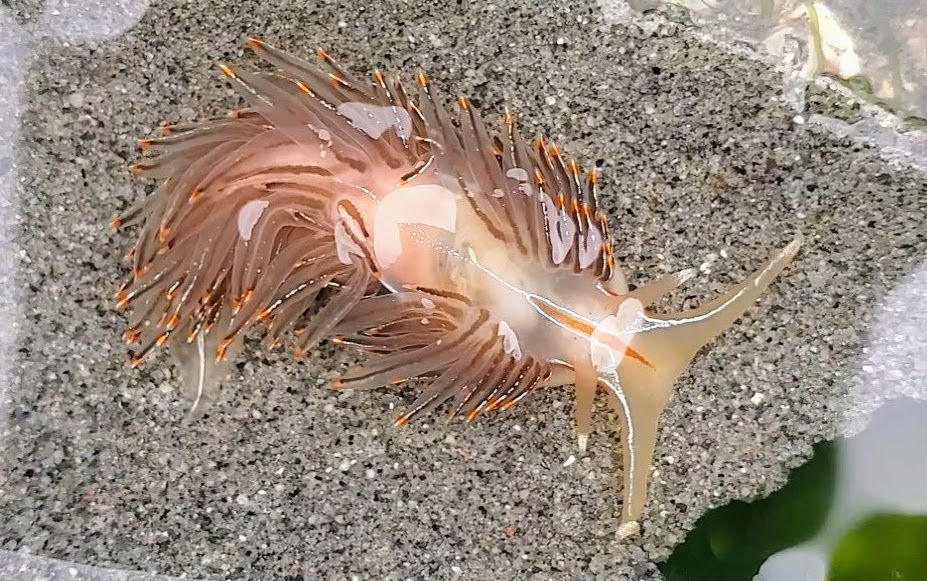Carkeek Park has numerous attractive attributes for an adventure but is well worth visiting for its low tide alone. There is one main beach at Carkeek , accessible by a pedestrian bridge leading over the railroad tracks from the lower parking lot. If you have the time, start from one of the park's boarder entrances and walk your way in. This park is full of fun little fungus-lined trails and can also be a real slug-fest.
After crossing the bridge, be prepared to walk through quite a bit of sand before you reach the water's edge. The best places to look will be to the north in areas that normally would be accessible. Head towards a very large rock that will be prominent when the tide recedes. Along the way there will be much to see, but the real pay off will be the large rocks and all the creatures nestled around it.
To the south there will be more to see, but as there are fewer large rocks on this side it will take a bit more care to find creatures. For an extended low tide adventure you may walk all the way along the beach to Golden Gardens, about three miles away. For this adventure you will need to mind your timing. Your path will quickly be covered when the tide returns so plan wisely to avoid being marooned.

Mottled Stars
While not as abundant as ochre stars, mottled stars can be observed with regularity at Carkeek Park. If you typically struggle to distinguish the two this is a great spot to compare the species side by side. Typically mottled stars will have longer, more slender arms and a smaller central disk. I find that these are less commonly attached to rocks than other star species. Often they are partially clinging to a rock near its base or are simply found lying on the sand.

Mottled Sea Star

Mottled Sea Star

Mottled Sea Star

Mottled Sea Star
Ochre Stars
At Carkeek, ochre stars dominate the biological landscape. Though often found clinging to rocks, in crevices, ochre stars may occasionally be found upon the beach too. Many specimens can be quite large, with an almost bloated appearance! The color of the ochre stars here seems to represent a spectrum from deep purple to pink.

Ochre Star

Ochre Star

Ochre Star & Mottled Star

Ochre Star
Red Sea Cucumber
At Carkeek, red sea cucumbers can be found in their typical haunts. They are easy to spot in rock crevices or dangling from a surface. You are likely to see more of the whole organism than just its tentacles.

Red Sea Cucumber

Red Sea Cucumber

Red Sea Cucumber

Red Sea Cucumber
Sea Slugs
The two types of sea slug I have seen at Carkeek are the thick-horned nudibranch and the Monterey doris. Once again a moon snail casing provided a suitable hiding spot for the thick-horned nudibranch. When out of water these may be balled up and look somewhat featureless. Gently anoint the creature with a bit of sea water and it will likely reanimate. The doris could easily be overlooked as it assumes a dull hue when out of the water. If you see a squishy-looking shell-less brown creature adhering to a rock, there's a good chance it could be a doris.

Thick-horned nudibranch

Monterey Doris

Thick-horned nudibranch
Anemones
A good variety of anemones may be observed at Carkeek Park, many of which you will need to watch out for underfoot! Aggregating anemones can be found on almost any surface on this beach, including in the sand. You might find it quite tricky to avoid stepping on them. Moonglow anemones may also be found partially buried in the sand, but unlike the aggregating anemones, moonglows are solitary. Large anemones, such as the painted and plumose anemones, can be found dangling from rocks, typically closer to the base. Watch out as the occasional painted anemone may crop up from the sand!

Plumose Anemone

Painted Anemone

Moonglow Anemone

Plumose Anemone
Ribbon Worms
These ribbon worms were exposed by a large rock that was moved by a human during low tide. These creatures, and other rock inhabitants, were disturbed and likely suffered for it. Nonetheless it provided an excellent opportunity to observe a large mass of these worms.



Mottled sea star walking across the sand

Ribbon worms in the sand

Thick-horned nudibranch inside a moon snail egg casing
Aggregating anemone in the water

LOCATION
It's easy to find the beach at Carkeek. There's multiple entrances and paths through the park. As long as you are heading west and downwards you'll be on the right track. For the less adventurous, or more restricted, simply park next to the beach in the lower lot. Take the pedestrian bridge over the railroad tracks and head straight down to the beach. To the north you will find the larger rocks where multiple organisms are easy to find.




